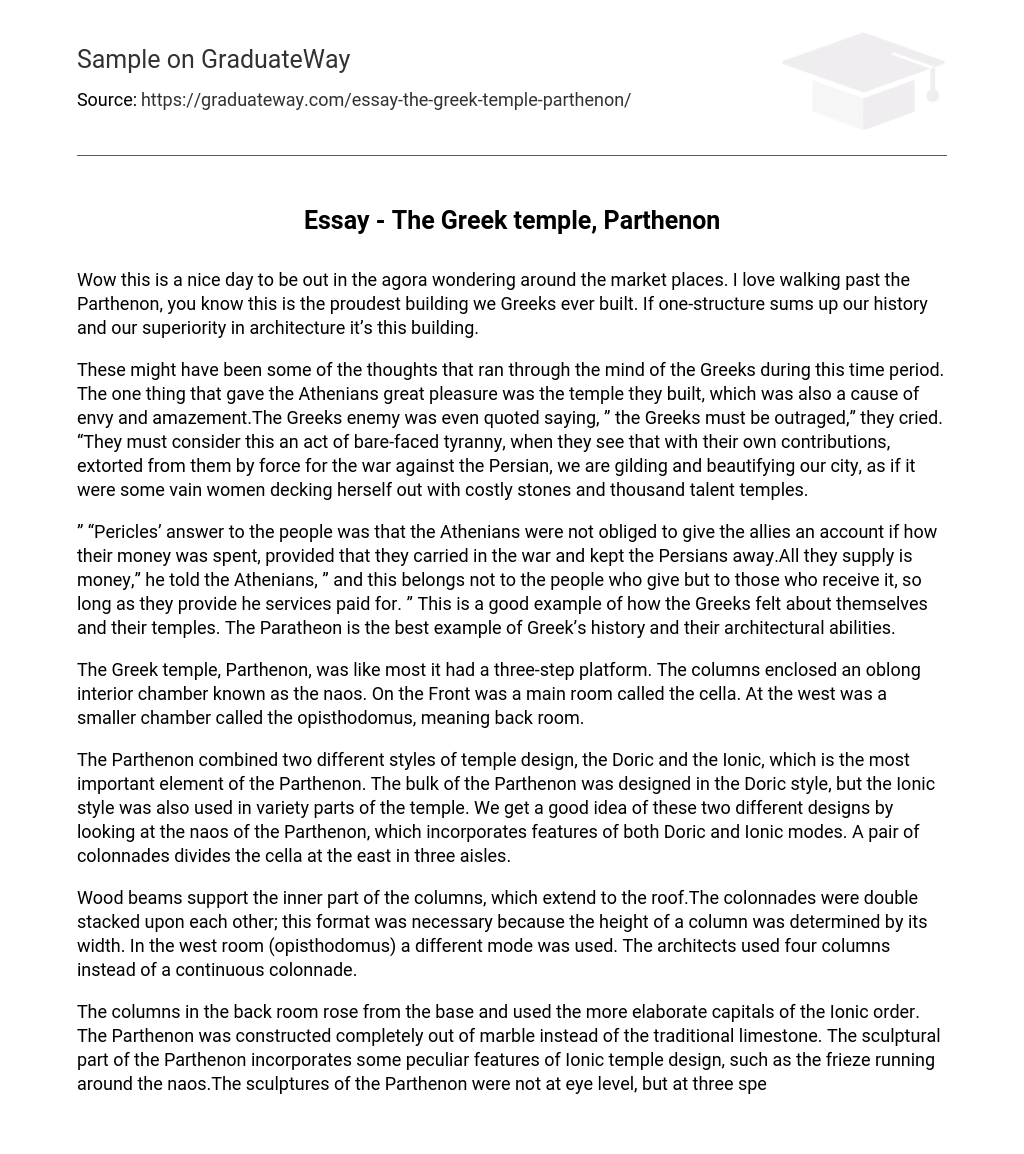Wow, today is a beautiful day to explore the marketplaces in the agora. I enjoy strolling by the Parthenon, as it represents the pinnacle of Greek architecture. This majestic structure encapsulates our rich history and our mastery in architectural design.
During this time period, the Greeks likely had various thoughts running through their minds. However, the Athenians found great pleasure in the temple they constructed, which also sparked envy and amazement. Even the Greeks’ enemies were heard exclaiming, “the Greeks must be outraged!” They claimed that it was an act of tyranny for the Greeks to use contributions forcibly extracted from them for the war against Persia to adorn and enhance their city, as if it were an extravagant woman adorning herself with expensive jewels and temples worth thousands of talents.
“Pericles’ response to the Athenian people was that they were not required to report to the allies about the expenditure of their money. Their only obligation was to contribute to the war effort and protect against the Persians. As Pericles said to the Athenians, “All they supply is money, and this belongs not to the people who give but to those who receive it, as long as they deliver the services paid for.” This demonstrates the Greeks’ perception of themselves and their temples. The Parthenon serves as a prime illustration of Greek history and their prowess in architecture.
The Parthenon, a Greek temple, had a typical structure with a three-step platform. The columns surrounded an oblong interior chamber referred to as the naos. The front housed a main room known as the cella, while at the west, there was a smaller chamber called the opisthodomus, which translates to back room.
The Parthenon is a unique blend of two distinct temple designs, namely the Doric and the Ionic styles. This combination is the key defining characteristic of the Parthenon. While the majority of the temple’s design adheres to the Doric style, elements of the Ionic style are also utilized in various sections of the building. A closer observation of the naos of the Parthenon reveals a fusion of both Doric and Ionic features, providing us with a clear understanding of these two contrasting designs. The eastern region of the cella is divided into three aisles by a pair of colonnades.
Wood beams serve as support for the inner portion of the columns, which reach all the way up to the roof. The colannades were stacked on top of one another, a design choice determined by each column’s height being dependent on its width. In the west room (opisthodomus), a different approach was taken, with the use of four individual columns instead of a continuous colonnade.
The Parthenon, constructed entirely of marble rather than limestone, featured columns in the back room with more ornate capitals in the Ionic order. The sculptural portion of the temple integrated certain distinctive elements of Ionic temple design, including a frieze encircling the naos. The Parthenon’s sculptures were positioned not at eye level but at three specific locations.
On the exterior of the temple, there were stone blocks called metopes, which were adorned with carved figurative scenes. Just above these metopes and triglyphs, there were triangles below the roofline. Lastly, there was a frieze measuring one meter in height located beneath the ceiling on all four walls of the naos. The remaining section of this frieze is now on display at the Museum of London.
Elgin took the sculptures from the Parthenon without the Turks’ permission. By examining the sculptures on the Parthenon, one can learn about Greek history. The thirty-fourth metopes on the north side depicted the Trojan War, while the twelfth metopes on the west side depict the Greeks battling the amazons. On the opposite side, there is a depiction of the battle of the Olympian gods.
The south flank of the metopes portrays the battle between the Lapiths and the Centaurs. The first relief sculpture can be found on the frieze of the naos exterior wall. This frieze on the Parthenon aims to combine the mainland Doric temple with the Ionic design of Asia Minor. Moreover, it portrays the people of Athens rather than the deities.
The Parthenon, one of the world’s most famous structures, is often desired to be seen by many. However, truly understanding its significance may elude most. Beyond being a resilient edifice that has weathered countless wars and human ravages, the Parthenon is a representation of Greek culture and architectural prowess. It allows us a glimpse into the essence of a magnificent civilization that thrived centuries ago.





